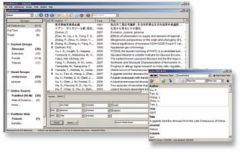Updated tool helps to organise references
Mhari Duncan believes that the new EndNote X2 from Thomson Reuters has many advantages over previous versions

If you have struggled to use the EndNote reference management software in the past, it is worth giving it a second chance. The new version, X2, delivers huge improvements in usability. This is largely due to better integration with electronic journal services and online databases. It is also much easier to use alongside EndNote Web, giving real flexibility when working with other people or in several locations. Thomson Reuters has really taken into account the needs of researchers when developing this latest version. Many timesaving features combine to make EndNote X2 an essential desktop tool.
The most obvious changes in EndNote centre around the use of Groups. Instead of seeing one huge library of references, you can use Groups to view references by categories of your choice. Groups are also used to list newly-downloaded references separately from your existing library. This serves as a useful ‘holding area’ and gives you a greater sense of control over your own library. Note, however, that the Groups are just ‘views’ or ‘queries’ of the library. The references are, in fact, all stored in one giant list as before.
Dragging a reference from one group to another does not move it, but rather includes it as part of both groups. This will be familiar if you use EndNote Web although you may miss the ‘unfiled’ group.
EndNote X2 introduces Smart Groups which work like database filters or saved searches. They are updated automatically as references are added to, or deleted from, your library. Why move references around yourself when you can have EndNote do it for you?
This is a fantastic time-saver for anyone comfortable with databases. My personal favourite – and I’m sure I will not be alone – is the Trash Group from where accidentally-deleted references can be dragged back to their original place in the library.
Transfer between EndNote and EndNote Web is now seamless and easy to manage. This opens up the possibility of sharing groups of references with research colleagues and students. It also means you can actually keep and (easily) use those references you found while studying away from home or your usual workplace.
Cite While You Write (CWYW) in Microsoft Word is also now easier to use while travelling or collaborating on a paper. It is easy to switch (using the CWYW preferences) between EndNote and EndNote Web within the same paper.
The process of searching online databases to populate your library is highly integrated with EndNote X2. Not only does the online search appear in the same tab as a library search but the references are immediately downloaded to a group in your EndNote library.
Full-text search is a much-advertised feature of EndNote X2 which downloads the full article text and attaches it to the reference. This could be a huge time and diskspace saver if used wisely as it makes EndNote the single source of all your references.
Output styles have been brought right up-to-date, as you would expect, and the inclusion of the Blog reference type will be a relief for many.
There is now a direct link to the Output Styles download page from the Help menu. This is not only a nice feature, but also an example of the relationship that Thomson seems to be trying to build with researchers.
Mhari Duncan is an IT Trainer at Heriot-Watt University, UK. If you are interested in trying out a new research information tool or resource and telling other readers what you think of it, please email Siân Harris at sian.harris@europascience.com.






